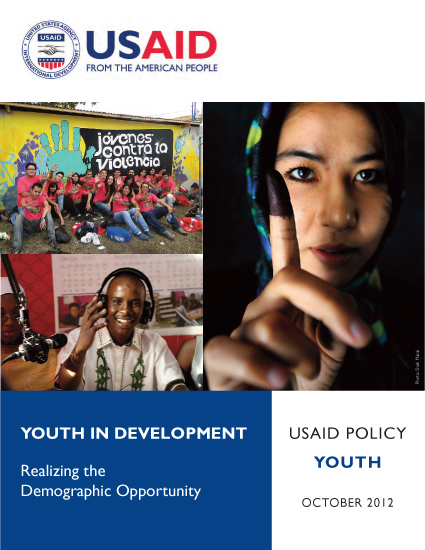Speeches Shim
![]() (1 MB) Youth in Development Policy
(1 MB) Youth in Development Policy
Executive Summary
This Policy on Youth in Development is the first of its kind for USAID. It is both timely and necessary as more than half of the world’s population today is under the age of 30,with the vast majority living in the developing world. As Secretary Clinton said in Tunisia in February 2012,“…in every region, responding to the needs and aspirations of young people is a crucial challenge for the future.”The policy is predicated on emerging best and promising practice for youth develop ment and engagement that are gleaned from USAID and partner’s experience in youth programming, as well as through consultations with young people across the developing world. The policy is further informed by principles and practices articulated in the Presidential Policy Directive on Global Development (PPD), the Quadrennial Diplomacy and Development Review (QDDR), the National Security Strategy 2010, State Department Youth Policy 2011, USAID Forward, and the USAID Policy Framework 2011-2015.
USAID has decades of valuable experience in leading efforts with young people and societies to enable safe and productive transition of youth to adulthood.However,USAID has not always approached its work with youth systematically.
This policy puts forward an overarching goal for youth development along with related objectives and outcomes to be achieved. It outlines a conceptual approach to youth in development and provides guiding principles and operational practices in support of USAID’s efforts to mainstream youth in development, carry out more effective programs, and elevate youth participation. Importantly,this policy will position USAID and its partners to capitalize on favorable global population trends by investing in programs and policies by,with, and for youth that seize opportunity and lead to sustainable growth and human development, including through the real ization of what is often referred to as a demographic dividend.
Goal: Improve the capacities and enable the aspirations of youth so that they can contribute to and benefit from more stable,democratic,and prosperous communities and nations.
Objectives
1: Strengthen youth programming, participation and partner ship in support of Agency development objectives.
2: Mainstream and integrate youth issues and engage young people across Agency initiatives and operations.
Expected Outcomes
- Youth are better able to access economic and social opportunities,share in economic growth, live healthy lives, and contribute to household, community, and national wellbeing.
- Youth fully participate in democratic and development processes, play active roles in peacebuilding and civil society, and are less involved in youth gangs, criminal networks, and insurgent organizations.
- Youth have a stronger voice in, and are better served by local and national institutions,with more robust and youth friendly policies.


Comment
Make a general inquiry or suggest an improvement.